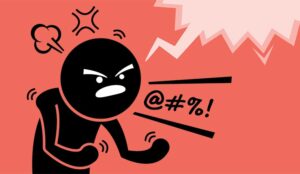Frank Sherlock of CallMiner introduces a three-stage process for handling abusive customers, by using interaction analytics in the contact centre.
- First, analyse every interaction to identify the main reasons why customers arrive angry or become angry on the call
- Second, monitor calls in real time and alert agents if the call looks like it is deteriorating
- Third, analyse every interaction to identify best-practice ways to calm customers down.
Find out the Underlying Cause and Fix the Problem
There may be occasions when contact centre agents are dealing with customers who arrive agitated and go on to become abusive. This means that agents are put in a difficult or unpleasant position from the outset. They will then be in recovery mode and will be expected to try and change the course of the call.
In reality, the customer’s frustration will probably be caused by a product or service failing to meet his or her expectations. Obviously, call centres cannot control products or services. But you can protect your agents by reducing the frequency of customers arriving frustrated.
You can do this by analysing every interaction and identifying the main reasons why customers arrive angry or become angry on the call. You can then pass this insight to the relevant department, who will hopefully make the necessary changes or improvements to eliminate the reasons for the call.
By monitoring and analysing all your customer interactions, you will also be able to recognise any emerging issues more quickly than by listening to a random selection of calls. This ‘early warning’ could mean a small problem can be resolved before it becomes a major issue.
Giving agents information on the likely cause of a sudden influx of angry customers contacting the centre will help them prepare to handle these calls better. This information will also help script appropriate responses to deal with difficult calls until the source of the problem is resolved. This kind of analysis makes the call centre a very valuable part of a company’s efforts to improve the whole customer journey.
Find Out What Is Likely to Trigger Abusive Behaviour While on the Call
There could be situations where certain agent behaviour, language, or even the tone of voice, may cause customers to become abusive. While these situations could be one-offs, it is highly likely that some will occur across the contact centre.
To gain the full picture, and recognise the scale of the problem as quickly as possible, you should monitor and analyse all your interactions. This should include measuring the relative sentiment or emotions on customer calls.
Using sentiment analysis will allow you to objectively identify specific factors, such as the amount of stress or frustration in a customer’s or agent’s voice (measures micro-tremors); how fast the individual is speaking (rate of speech); and changes in the level of stress indicated by the person’s speech (such as in response to a solution provided by a customer support representative). This kind of technology will capture the entire context of a discussion, including the way in which an agent has dealt with the situation.
By isolating the words, phrases or tone of voice that act as ‘anger triggers’, it is possible to coach agents to avoid them at all costs.
“Don’t Cure It – Prevent It” by Providing Agents With Real-Time Next-Best-Action Advice
Sometimes conversations that agents have with their customers can take a bad turn. Usually there are some indicators suggesting that the customer is getting increasingly frustrated or agitated. These may be in the form of a change of rate of speech, speaking louder or interrupting. Although an agent will probably recognise that the conversation is deteriorating, he or she may not always be able to remain calm and deal with the situation rationally.
Providing agents with a real-time warning that the call is deteriorating can help to deliver better customer outcomes. This is much more likely to happen if the warning is accompanied by next-best-action guidance on how to get the call back on track.
Giving agents these kinds of tools protects them from an abusive experience and enables them to turn an agitated caller into a satisfied customer.
Identify and Share Best-Practice Ways to Calm Customers Down
Every call centre has high-performing agents – the agent that seems to be great at handling difficult calls. But do you really know the secret of their success?

Frank Sherlock
By analysing every interaction, it’s possible to identify exactly how these agents turn a difficult call into a good customer outcome. This could include words and phrases that show empathy and put the customer at ease. It could identify great listening skills that help to isolate the source of the customer’s problem.
Once you’ve identified their ‘secret sauce’, you can share it with other agents and provide coaching to raise the game of the whole team.
Author: Robyn Coppell
Published On: 19th Feb 2018 - Last modified: 21st Feb 2018
Read more about - Guest Blogs, CallMiner



















